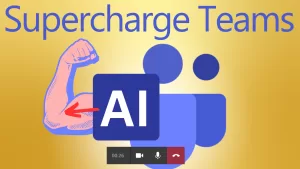Are you tired of wasting precious time in meetings, only to leave feeling confused and disorganised?
Do you struggle to keep track of all the action items and follow-up tasks that come out of these meetings?
Microsoft Teams has launched a new feature which could solve your problems and boost productivity.
Meeting Recap is an AI-based intelligent meeting recap feature, available exclusively to Teams Premium subscribers. This innovative feature harnesses the latest in artificial intelligence technology to generate comprehensive summaries of your meetings.
That means no more tedious recaps… but hello to accurate and efficient summaries that capture all the key points from your meetings.
The Meeting Recap feature doesn’t stop there. It automatically identifies action items and follow-up tasks, assigns them to team members, and even sets deadlines for completion. This means that everyone involved in the meeting knows exactly what they need to do and when it needs to be done. A great way to improve communication and collaboration within your team.
But it’s not just about efficiency. The meeting recap feature also offers customisable options to tailor the feature to your specific needs. Choose what information is included in the summary to ensure that you receive the most relevant and useful information possible.
If you’re not a Teams Premium subscriber, are there benefits of investing in this new feature?
Yes! For starters, it streamlines your workflow, saving you both time and money.
You don’t have to waste hours trying to decipher meeting notes and action items. Instead, you’ll have access to a clear and concise summary that you can refer back to any time.
Additionally, it improves organisation and accountability within your team. With assigned action items and deadlines, everyone knows exactly what is expected of them.
Don’t underestimate the power of this new Meeting Recap – it’s a game-changer for businesses that want to increase productivity.
Don’t wait. If you need help upgrading to Teams Premium, we’re here for you. Get in touch.




Recent Comments